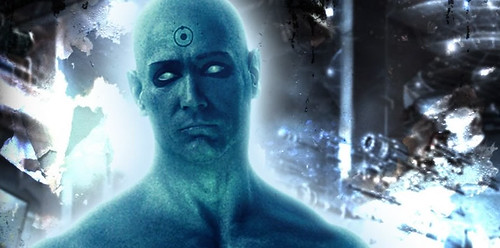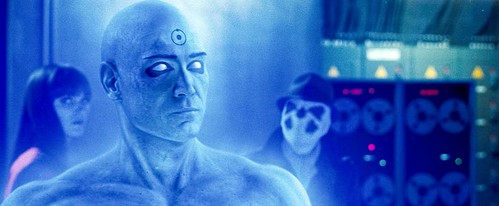Monday, 12:04am
9 March 2009
Blue (nerd) heaven?

Last year I aired some reservations regarding Zack Snyder’s then-forthcoming adaptation of Watchmen, the acclaimed graphic novel by Dave Gibbons and Alan Moore, writes David Thompson.
One of the concerns was that, since the comic’s initial publication in 1986, many of its themes have been explored and copied elsewhere – most obviously in Pixar’s The Incredibles and in the TV series Heroes, the first season of which borrows a major plot point.
Less obviously, but more importantly, the pleasures of Moore’s story often hinge on how the story is told – i.e. as a comic book. The unusual richness of Watchmen emerges from repeated reading, from skipping back to earlier pages and spotting clues and counterpoint. This revisiting of past events and discerning patterns is a theme of the story itself and is embodied by the character of Dr Manhattan (below). How this accumulation of detail might translate to a very different, more linear, medium wasn’t clear. Yet, despite this, it was tempting to see how Watchmen would look writ large. And, having now seen the film, it’s this curiosity to which director Snyder plays his hand. This is a film for fans and the morbidly curious.
Comic enthusiasts have argued at eye-watering length over what is absent from the 161-minute theatrical release. The Tales of the Black Freighter pirate story is gone, and not missed, and the infamous MacGuffin of the final act – an enormous psychic calamari that devastates Manhattan – has been replaced with something less outlandish and more economical.
What is felt as missing, at least by the film’s end, are the minor background characters and the sense of a world at stake. The newsvendor and his customer, for instance, are glimpsed only once before they, and much of New York, vanish into atoms, an omission that robs their last moments – and the film - of poignancy. Thus, when Adrian Veidt’s nightmare ‘solution’ is finally delivered, it’s visually remarkable but emotionally subdued. In the comic, Moore and Gibbons spend nine pages showing us the cost of ‘saving the world’. Snyder’s depiction is brief and oddly bloodless - a puzzling decision given his earlier, very evident, delight in viscera.
So, is Watchmen ‘unfilmable’, as Moore insisted? Well, Snyder’s impressive visual fidelity has come at a price. The film is frequently striking and surreal, often beautiful, but it’s also disjointed in tone and strangely undramatic. Despite its formidable running time, Watchmen is never boring – there’s always something to watch, some reference to spot – and the extended opening credits are close to nerd heaven.
However, this virtuoso montage is one of the film’s strongest sequences, which suggests that audience satisfaction may depend on familiarity with the comic. For detail obsessives, there are plenty of small joys along the way. Dr Manhattan’s luminous anatomy is lovingly rendered, John Higgins’ skewed colour palette is carefully reproduced, and even Veidt’s computer files make for interesting reading. But as the end of the world looms, the pervasive mood is one of stillness and detachment; only Rorschach’s prison scenes generate momentum.
Elsewhere, there is little tension or urgency. And, told as a film, this matters. Yes, Gibbons’ imagery is reproduced fastidiously and often to great effect, and much of Moore’s dialogue is used verbatim, with mixed results. But the lingering pleasure derived from reading (and re-reading) Watchmen remains somewhat elusive in this striking, uneven and ambitious film. What Snyder delivers is, above all, an arresting visual curio – surprisingly lifeless, but fascinating nonetheless. If the definition of a classic work is the urge to revisit it, then the Watchmen comic is a classic. Whether Synder’s film will reward repeated viewings isn’t clear. But see it, once at least.
Here’s the opening sequence:
![]()
Eye is the world’s most beautiful and collectable graphic design journal, published quarterly for professional designers, students and anyone interested in critical, informed writing about graphic design and visual culture. It is available from all good design bookshops and online at the Eye shop, where you can buy subscriptions and single issues.



